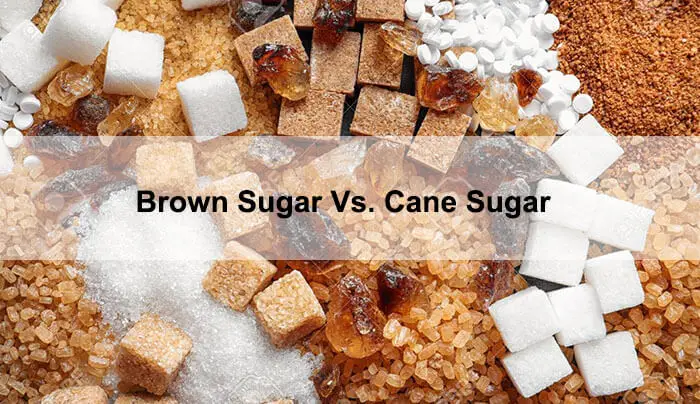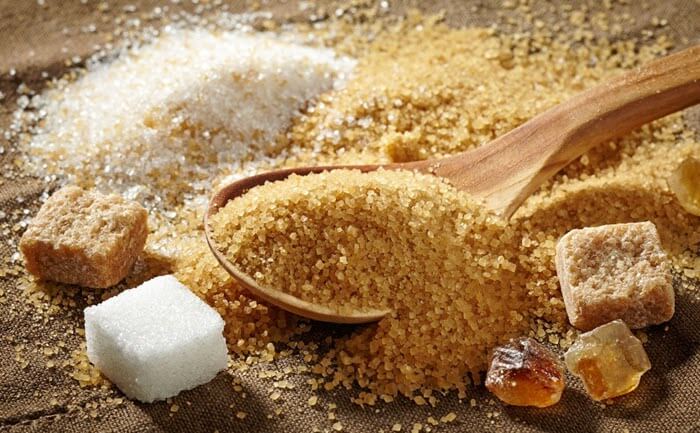One of the most common natural sweeteners in almost every kitchen is sugar. And while it’s available in many variants, the two common ones are brown sugar and cane sugar.
But how exactly do the two differ, and is one better than the other? This article on brown sugar vs. cane sugar looks into the similarities and differences between the two.
Table Of Contents
Brown Sugar Vs. Cane Sugar: Quick Facts
Cane Sugar | Brown Sugar |
Retained natural molasses. | Added in molasses. |
Tastes like vanilla | Light one: tastes like toffee |
Used for baking mousses, souflés, and meringues | Used for baking |
Golden color with smaller crystals | Darker in appearance with bigger crystals |
Higher calories | Slightly more minerals |
More expensive | Cheaper |
Is Cane Sugar the Same as Brown Sugar?
Cane sugar is not the same as brown sugar. These two sugars vary in many ways.
Cane sugar’s extraction process [1] involves heating cane juice and filtering it while retaining natural molasses and moisture. Cane sugar is organic because it’s still in its rawest form.
On the other hand, brown sugar is also obtained from sugarcane, undergoes the same boiling and filtration process. Only after filtration, the refined sugar crystals get coated with molasses, giving it its brown color.
Differences Between Brown Sugar and Cane Sugar
The only way to determine whether there is a clear winner in the brown sugar vs. cane sugar debate is to explore their differences, for they vary in flavor, taste, appearance, and use.
Below is a more detailed look at these differences:
Taste and Flavor
Cane sugar’s flavor has more depth due to the molasses and other minerals within the sugar crystals.
Brown sugar’s flavor may vary depending on the level of brownness as determined by the amount of molasses the sugar contains. If the sugar is light brown, it tastes a bit like toffee and caramel and is less complex. On the other hand, dark brown sugar has a more caramel-like taste and a more robust molasses flavor.
Usage and Food Preferences
Cane sugar is more suitable for preparing foods that require the dough to rise more. It tends to let in more air, giving a fluffier texture. Thus, cane sugar is an excellent choice for baking mousses, souflés, and meringues.
You also want to use cane sugar for the following:
- Savory dishes: It makes an excellent glaze for meat and enhances the sweet-smoky flavor of barbecue. Also, if you plan to marinate your meat or vegetables before grilling or roasting them, you can use cane sugar in your marinade.
- Desserts
- Liquids: Use cane sugar for your coffee to give it a sweet molasses flavor or as an additive to your salad dressings.
- Baked goods: It’s an excellent choice for confectionaries, including cakes, candies, and cookies.
On the other hand, brown sugar is common with baked goods. It lends a molasses texture and enhances the brown color.
Another difference is that the molasses in brown sugar makes it retain more moisture, making products softer. However, moisture content doesn’t work for all baked products. It’s unsuitable for baking cookies as they turn out chewy and less crisp.
Therefore, avoid using it to make such products and instead use it in denser and softer desserts. A perfect example is pecan pie which is moist on the outside but dry inside.
Other brown sugar uses include:
-
- Bread: The sugar is lighter than cane sugar, thus suitable for airy bread. It’s perfect for milk toast, bread rolls, regular bread loaf, and bread pudding.
- Bacon: Brown sugar gives bacon products a milder taste that doesn’t overpower the smoky-sweet taste. No wonder it’s the Bacon Producers’ favorite.
- Desserts: This sugar’s perfect moisture-retention properties make it a good choice for brownies, crumb cakes, chocolate-moist cakes, and caramel fudge.
- A sweetener for fruit juices.
It’s worth noting that brown sugar has other applications outside of the kitchen. These include:
- Exfoliating or scrubbing your body
- Removing stains from clothes
- Preserving cookies
- Removing smelly odors from your fridge
Appearance
Cane sugar has a golden color due to some molasses contained in the crystals. These crystals are smaller but slightly larger than your regular white sugar.
Brown sugar is darker in appearance due to the high molasses content. Also, the crystals are bigger. The brownness varies depending on the molasses content. The darker the brown hue, the higher the molasses content.
Nutritional Content
So which of the two sugar variants is healthier? Most people consider brown sugar to be of more nutritional value than cane sugar, but this is not true.
Both sugars (and all sugar in general, including honey) are a mixture of glucose, sucrose, and fructose. The only nutrition you derive from them [2] is calories (carbohydrates) which are beneficial for energy, and all are harmful if consumed in excess.
Price
Similarly, cane sugar is more expensive than brown sugar. That’s because cane sugar is at its rawest organic form.
Can I Use Cane Sugar Instead of Brown Sugar?
Yes, you can use cane sugar in place of brown sugar, coconut sugar, etc. In fact, cane sugar offers more body and depth and might be a better alternative.
However, looking at the culinary uses of both sugars, there’s not much difference. So, in any recipe you need brown sugar, you may use cane sugar as well- no harm whatsoever.
If you want a milder taste and more brown in your dishes, use brown sugar. If you prefer a stronger taste and deeper color for desserts and savory dishes, cane sugar is a perfect choice.
When substitute with each other, use a 1:1 ratio.
Wrap Up
In the cane sugar vs. brown sugar debate, we’ve established that both sugars come from the same source: sugarcane. Also, both contain molasses but in varying proportions, and neither is healthier than the other.
The difference between cane sugar and brown sugar is taste, flavor, appearance, cost, and uses. It all boils down to what you’re using it for, the effect you want, and your individual taste and preferences.
Related Post


